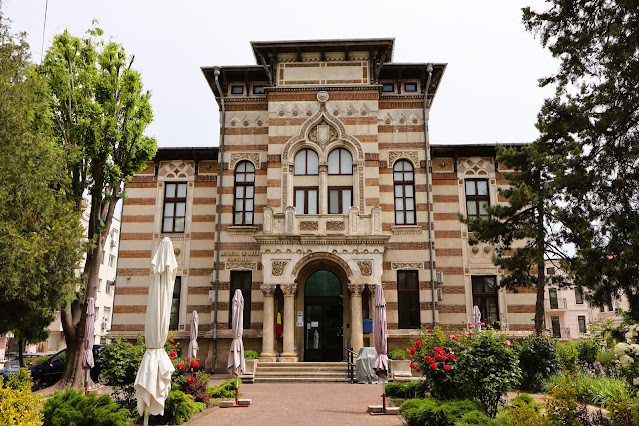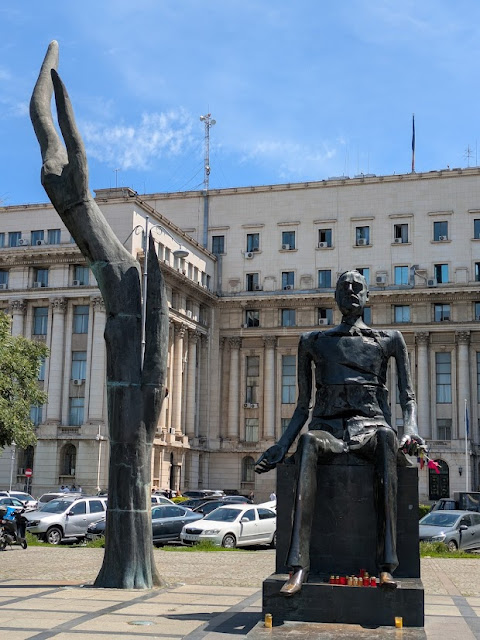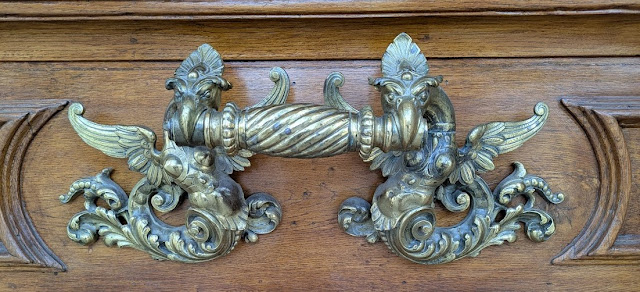This day starts with a ten in the morning tour of the Palace of the Parliament.
A long and impressive avenue leads up to this edifice, with fountains all along the median.
Our first glimpse of 'the Palace':
When Nicolae Ceaușescu started this project, he called it the House of the Republic and wanted it to serve both as parliament and as a residence for him and his family.This is still the largest administrative building in the world, and the heaviest. In size it is second only to the Pentagon. However, much controversy surrounds it.
First, historic neighbourhoods, including churches, monasteries and thousands of homes, were destroyed to make room for it. More than 40,000 people were displaced in the process.
The other major controversy swirls around the grand edifice with the finest of materials, utilizing many resources and diverting money away from essential services when ordinary citizens were forced to live within terrible austerity measures.
I DIGRESS
We are now about a week beyond Bucharest and have talked in some detail with four people (male and female) in different cities who lived during the time of Ceaușescu's dictatorship. The history books describe that time as one of oppressive human rights violations, including the violent and ruthless suppression of dissent which was enforced by his secret police force, economic and social policies that harmed the population leading to declines in living standards, shortages of essential goods, a rise in infant mortality and a decline in womens' reproductive health. Many landowners lost their property so that large-scale collective farms could be created. All of this and more led to the 1989 revolution and the subsequent execution of both Ceaușescu and his wife Elena.
Despite all of this, people had many good things to say about the dictator. A common statement was that he raised the standard of living for the ordinary person by building housing that had running water, toilets and other amenities and that after the execution, the government allowed people to buy these apartments at low cost, so that more than 85% of the population had home ownership. We heard grumbling that the governments since democracy have been riding on infrastructure created then and doing nothing so that things are now deteriorating.
Another sentiment was that Ceaușescu caused Romania to be very independent, leading to very few imports and many exports, bringing the country's national debt to zero. In concert with this expression was that back then everyone had work, and now there is no work and youth either don't know what to do with themselves or are leaving to work in other countries.
A sentiment was that back then people had no money, but they were provided for, and now they have money, but it buys little, and there is too much importing of costly Western products (also leading to the thought that banks and politicians are corrupt and taking money from the pockets of the people).
These were surprising revelations to us and all of it makes our minds swirl with questions. The people we had these discussions with all seemed pretty well off, more so than we can imagine they could be during the totalitarian regime years. Three of them owned the accommodations that we stayed in, and two drove pretty high-end cars. Another lives in America but owns two apartments on the beach in a Romanian city and has seen a fair bit of the world.
We have more reading to do on the subject.
BACK to the PALACE of PARLIAMENT
The internet can provide statistics on the immensity of this place. Data like it is 365,000 square meters; it has twelve stories above-ground and eight stories below; there are over a thousand rooms; some of the 480 chandeliers weigh thousands of tons each; there are 1,409 ceiling lights and mirrors; a million cubic meters of marble, 550,000 tons of concrete, 700,000 tons of steel, 900,000 cubic meters of the finest wood; and on and on.
Here are some of the chandeliers, lights and the gilded ceilings in which they are placed.
The doors, walls and floors in the next few photos illustrate the quality of the wood throughout.
Ruschita marble brought in from around the county included white, black, and the beautiful pink as in the first photo of the sweeping staircase and the decorative highlights in the photograph that follows.
Below is one illustration of how tons of glass was incorporated into the building.
Meeting and social rooms are immense. This is a close-up of a more casual room where guests might be served tea. The camera couldn't capture the entire room.
An example of a more formal meeting room at a round table.
Many of the hallways are so long that you're not sure if you can see to the end of them.
Workers are in the building daily, but as much as seventy percent may not be in use.
One can't help but marvel at the beauty and craftsmanship conceived by Ceaucșescu, and its execution by the twenty-eight-year-old architect, Anca Petrescu, but the cost to the people and the country is always back-of-mind.
REVOLUTION SQUARE (Piata Revolutiei)
The name of this square hints at its historical importance. Nicolae gave his last public speech from a building that looks down on this square. He so angered the citizens that their hostile reaction that day culminated in the 1989 overthrow of him and his communist regime.
Iuliu Maniu, represented in the statue (below photo) was Prime Minister of Romania three times between 1925 and 1933. His 'crime' was that he opposed the presence and influence of the Soviet Union in Romania, and for that he was sentenced to a life of hard labour in prison, and he died six years later.
The creator of the statue wanted to catch the spirit of a broken man, with an unbreakable spirit.
In 2005, the Memorial of Rebirth was erected to commemorate the victory of the revolution and of communist repression. Apparently, it is liked by some and not by others.
The beautiful Romanian Athenaeum concert hall, home to the Philharmonic Orchestra, is an anchor in Revolution Square, and its brilliant dome begs one to see more.
The sweeping main staircase and the supports to auxiliary staircases are majestic
The building was funded primarily through small public donations, with the widespread slogan "Give one leu for the Anthenaeum" and is considered the people's building and plays a major role in the musical and artistic life of the country.
A crew is setting up for tonight's performance.
Inside is a massive painting that encircles the entire dome, and is both a work of art and a history lesson. It depicts scenes from the history of Romania.
It seats eight hundred people in a horseshoe shape.
Details in decoration are gradually absorbed and appreciated.
Descending the stairs and looking down into the lobby.
Sadly, we have no time for a concert.
On the day we were there, a graduating class from a nearby university was hanging out, having their photos taken, and they were pleased when some tourists (like us) wanted to capture their moment.
Other significant buildings in Revolution Square are the "Carol I" Central University Library of Bucharest.
... and the National Museum of Art, a photo of which can be found on the internet.
UMBRELLA STREET
This passageway between Victory Avenue and another major street in Bucharest is a peaceful respite from the crowds and cars, and the bright canopy of umbrellas serves to lift one's spirits. We linger there a while.
Victory Avenue has been Bucharest's most important street since the 1600s, when Prince Brancoveanu built this throughfare from his royal court in Old Town and his palace in a village north of town. It was the first street to have lights (1814) and the first to be paved (1842). Today, it has the most expensive shops and hotels in the city, and is a favourite for tourists and well-heeled locals alike.
We are off to Constanta next, on the way to Tulcea and the Danube Delta. We are in Tulcea now and behind on posting due to poor Wi-Fi connections.
MISCELLANEOUS PHOTOS FROM AROUND BUCHAREST
Handle on outside door at the concert hall.






































.jpg)






































